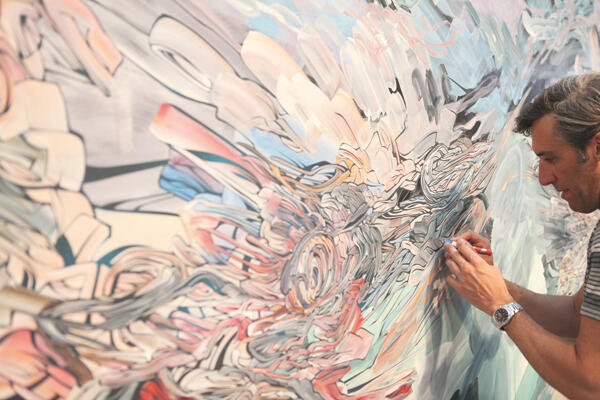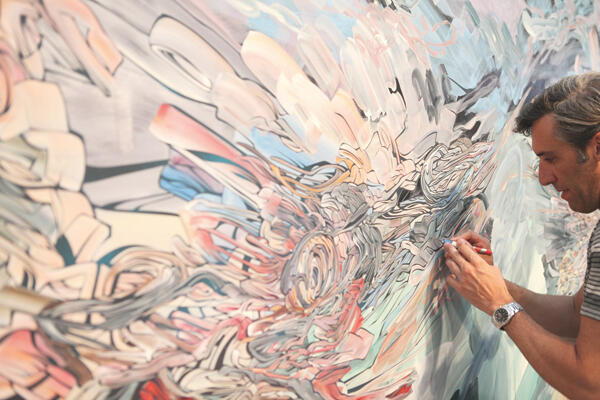Emilio Perez
A Painter’s Painter
New York
Emilio Perez was born in New York and raised in Miami, Florida. In 1990, at the age of 18, he moved back to New York to attend the Pratt Institute and returned to Miami two years later to complete his Bachelor of Arts in Fine Art at the New World School of the Arts.

Following his studies he began to experiment with paint on wood panel, developing a unique style that he continues to advance. His work has been exhibited as part of group exhibitions at galleries and museums throughout the USA, including the Albright-Knox gallery in Buffalo and the Bass Museum of Art in Miami, as well as internationally in Israel, Germany, Norway, Italy and Canada. Emilio Perez has had thirteen solo exhibitions, predominantly in Miami and New York City; however, his recent exhibition titled “Rivers Always Meet the Sea” was featured at Galerie Lelong in Paris, France. Perez’s work has been widely collected by museums and foundations, as well as by corporate collections including the Miami Art Museum, Fundación Arco Madrid, the Bank of America Art Collection and the Albright Knox Gallery. Emilio Perez lives and works in New York.
At a time when the contemporary art world has an insatiable appetite for the spectacular, as expressed through media such as installation, video and performance, it would appear obsolete for an artist to enter into an exclusive dialogue with the history and methodologies of painting. However, as painting seems to continually reinvent itself (in her 2010 article, “Its Not Dry Yet”, Roberta Smith confirmed that painting is in fact not dead and is continually pushing its own boundaries), there would be no truer or more earnest investment than to spend one’s career exploring the possibilities of paint. In fact, Emilio Perez’s interest in the action of painting, as a direct and honest expression, fundamentally aligns him with the philosophy of the Abstract Expressionists and Action Painters of the past. In this way, Emilio Perez is a painter’s painter. Using this philosophy as the basis of his practice, he then expands his technique by “drawing” on the surface of the work making precise and detailed cuttings. This lends a dimension of order to a seemingly chaotic underbelly of brushstrokes that uniquely melds the mediums of painting and drawing. Perez developed this technique in conjunction with his life experiences, making his work in many ways an extension of his personality. Consequently, Perez’s biography and dynamism are integral to understanding the logic of his process and his approach to making paintings.
Paradoxically, Emilio Perez is both edgy and kind. It is perhaps these opposing characteristics of his personality that allow for the “intuitive” and expressive brushstrokes and the “rational” and precise drawing to cohabitate in his work. He describes himself as energy-filled and in search of instant gratification, which is how he discovered his process. Too impatient to wait for the painted surface to dry, Perez began cutting at it, moving around the layers of wet paint. During this play, he discovered a technique that added a layer of detail and order to the violent gestural marks underneath. This affords the work a graphic refinement akin to that of an exquisitely carved linocut, penetrating the painting with an added sculptural dimension that suggests the hyper-real. In fact, the precise markings of his cuts afford his paintings a graphic quality that has been equated with a range of style aesthetics. However, these aesthetic deductions are generally too literal and simplistic.
Perez’s work has also been associated with a variety of artistic styles. The spontaneous action of his paint application and his sprawling compositions create movement beyond the frame of the painting which has been commonly correlated with Jackson Pollock’s gestural paintings—the lines of Perez’s cutouts in effect mirroring the layered lines of Pollock’s dripped paint. However, the deliberate nature of his cutting process denies a purely action-based result. It can also be observed that Perez shares a sensibility for creating perspective and depth with Leipzig painter David Schnell, both of them layering line above gestural markings to activate the surface layers and evoke a sense of movement and depth. The end result of Perez’s work is, however, very different to that of Schnell’s, whose hyper-real landscapes displace the viewer in time and space by offering an altered reality. Instead, Perez offers a timeless and unending space that places the viewer in an indecipherable middle ground between the expressive and the possibility of representation. For Perez neither force is possible in entirety, and they battle the painting’s surface in an ordered chaos that is both provocative and appealing.
While all of these associations are valid inasmuch as they are part of Perez’s subconscious, they are in fact only peripheral to the true intention of his work, which is largely intuitive. In this way, direct comparisons are insufficient at capturing the whole of Perez’s work, and thus his paintings defy classification. Instead, Perez’s works represent a true marriage between the genre of painting and a personal contemporary dialogue. In fact, using a format of the painting grid, Perez views his larger works as landscapes and his smaller pieces as intimate portraits. This traditional format is accessible and unobtrusive, allowing the artist to place an emphasis on the visual in the works’ composition. Inspired by the Kodak Coloramas of the 1950’s that placed people, objects and colors within vivid and epic landscapes, Perez composes his paintings using graphic forms and concentrated color to create reinterpretations of the landscape in abstract form.
Drawing on visual stimulus from his environment for inspiration, Perez selects his color palette and constructs his compositions intuitively. Congruously, each series of work is unique and made cohesive by a common color palette connected to his experience of travel and living at that particular time—his intuition guiding his actions and choices throughout his process. In 2011, his exhibition Rivers Always Meet the Sea in Paris, France, comprised work that carried a range of dark green, blue and brown tones inspired by the copper roofs of Parisian historical buildings that surrounded him during his stay. Specifically, in his work Keeping Down Confusion, Perez drew on the intensities of this environment by composing concentrated colors in patchworks of sprawling forms, injecting the work with energy but also with a strong associative quality through its color. In this way, Perez becomes a conduit of his experiences, creating work that is rooted in the present and “of the moment.”
In addition, his intuitive approach to the cutting process relinquishes conscious control, allowing the work to evolve organically and the abstract puzzle to reveal itself. His intuition also kicks in to tell him when the painting is finished. Once complete, viewing Perez’ works is bearing witness to the painted action that depicts an evolving conversation between the artist and his paint that, unlike sculpture, which is a less flexible medium for Perez, is reactionary and spontaneous. This spontaneity, contained by the regulation of the reductive mark-making process, forms a complete dialogue between the inherent qualities of painting and drawing.
As a consequence of the expectation for artists to experiment with a variety of media, Perez has been criticized for being intransigent in his approach to painting. In response, he created a site-specific vinyl wall wrap that appeared spectacular and vivid, yet lacked the tactility and liveliness of his celebrated painted surfaces. Instead, Perez chooses to increasingly immerse himself in the possibilities of painting and drawing. Dedicated to adding dimension to his painted surfaces, he investigates how to make the backgrounds of his work more painterly and how to further integrate the surface layers of mark making.
Citing the rhythms of music (ranging from rock to jazz) as a source of inspiration, Perez would ideally like to work even faster. Fresh off a residency at Lux Art Institute at Encinitas in Southern California, Perez spent a month working on a triptych aptly titled All I Can Say and explaining his process to visitors. Deceptively, the intricate surfaces of Perez’s paintings are created using a two-stage process. Beginning with a wood panel as a base, Perez quickly and loosely layers the surface with over a gallon of acrylic and latex paint in large sweeping brushstrokes. Then, using an X-Acto knife, he cuts away at the surface to create drawings by revealing the paint and color below, making a roadmap of lines that leave tendrils of paint layered on his studio floor. He finds satisfaction peeling off painted layers, stating that it “appeals to a fundamental joy in all of us”, describing this action as “turning a two-dimensional object into something more.” The result is an illusory effect or “trompe l'oeil” of depth and perspective. Ordinarily, a single painting with all of its layering and reducing would take Perez longer than a month to complete. However, he was able to complete the triptych during the residency.
Ultimately, it is Perez’s intuition that combines a wide range of inspirations within the boundaries of painting and drawing, making him a master at “mixing”. In fact, Perez gets the titles of his work using this same method of sourcing and mixing. He collects words from song titles, the radio, newspapers and advertisements and creates phrases and combinations that are playful, yet purposefully ambiguous. His only criteria are that the titles need to evoke an action suggested by the works content. In this way, our free associations to these words function in the same way we associate to Perez’s suggestive colors, composition and mark making—they allow us to imagine. His ability to absorb and reinterpret his experiences into paint in a way that is free of hierarchies of form, honest in his intuitive associations to color and composition, and evocative through an epic abstraction, affords Perez’s work a disarming honesty and an intoxicating intensity. When the rest of the contemporary art world is fixated with continuously exploring new mediums of expression, Perez continues to delve further into painting.
“Don't play what's there; play what's not there.”
Miles Davis, Jazz musician
.......................................................
-
 Keeping Down Confusion, 2011.
Keeping Down Confusion, 2011.
Acrylic and latex on wood panel, 60 x 54 in.
© Emilio Perez. Courtesy of Galerie Lelong, New York. -
 See and Don't See, 2011.
See and Don't See, 2011.
Acrylic and latex on wood panel, 60 x 72 in.
© Emilio Perez. Courtesy of Galerie Lelong, New York. -
 California, 2011. © Emilio Perez. Courtesy of Galerie Lelong, New York. C
California, 2011. © Emilio Perez. Courtesy of Galerie Lelong, New York. C
Photo: Stacy Keck




